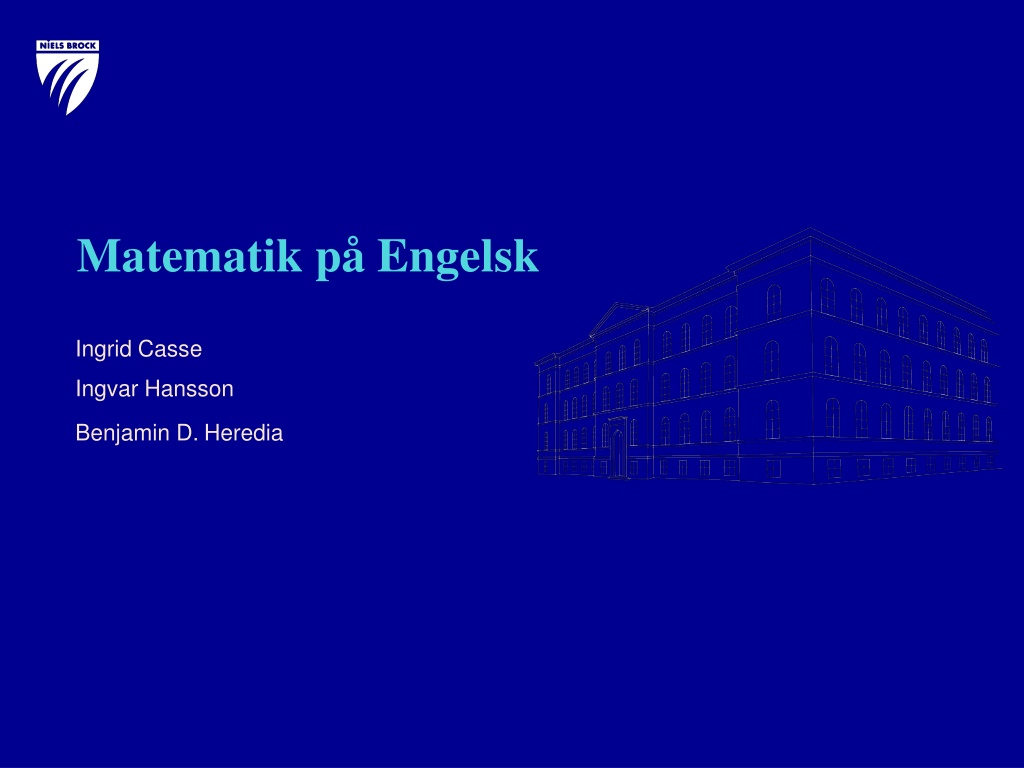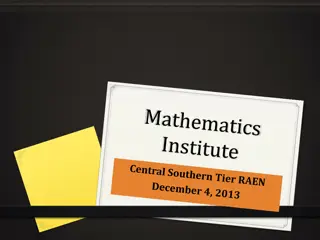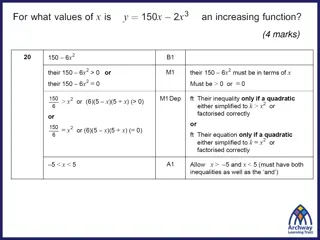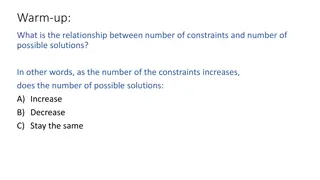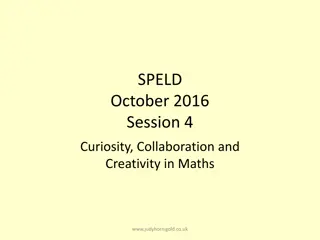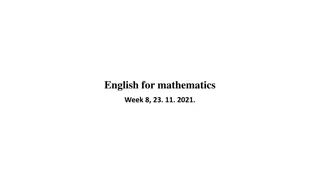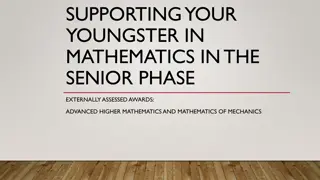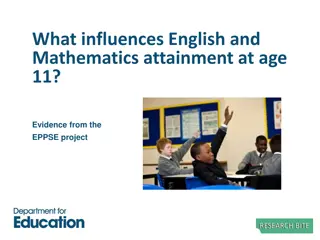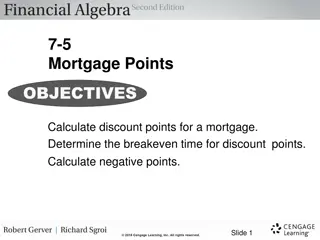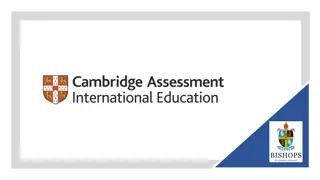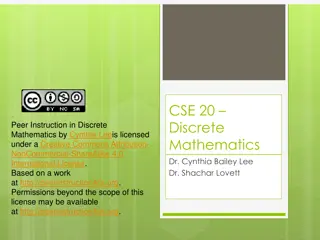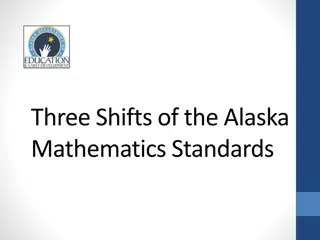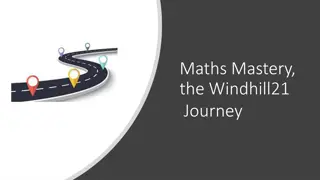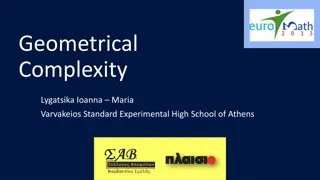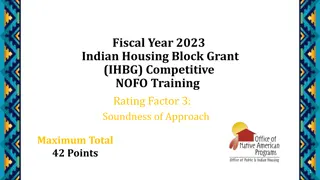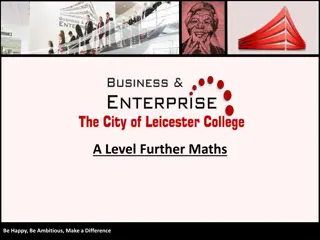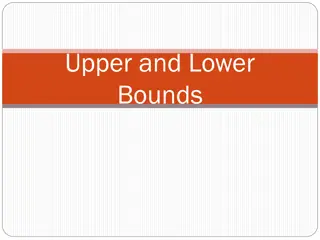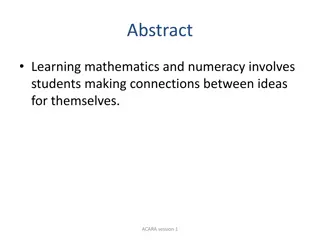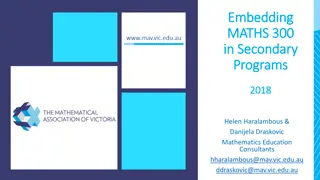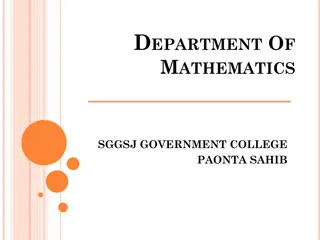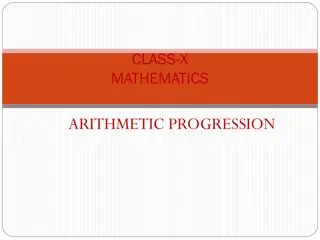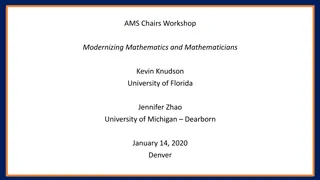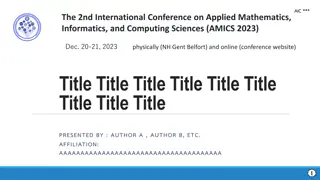Mathematics in English at HHX - Focus Points and Possible Solutions
The article discusses the focus points and possible solutions for teaching mathematics in English at HHX, highlighting topics like technical English, vocabulary variation, student backgrounds, and terminology differences between UK and US. Possible solutions include developing custom materials, selecting chapters from various sources, and utilizing websites and videos for teaching support.
Download Presentation

Please find below an Image/Link to download the presentation.
The content on the website is provided AS IS for your information and personal use only. It may not be sold, licensed, or shared on other websites without obtaining consent from the author. Download presentation by click this link. If you encounter any issues during the download, it is possible that the publisher has removed the file from their server.
E N D
Presentation Transcript
Matematik p Engelsk Ingrid Casse Ingvar Hansson Benjamin D. Heredia
Mathematics in English at HHX Focus Points T echnical English as language Vocabulary Variation No corresponding English textbook T eaching Topics No direct correlation between English textbooks and Danish textbooks
Mathematics in English at HHX Focus Points New vocabulary Student background English as language Variation in student s language skills Business Economics Inter- disciplinary work Marketing International economics Evt. other subjects.
Mathematics in English at HHX Focus Points T erminology English as language UK vs. US Mathematic symbols, i.e. uses of letters Europe vs. American tradition Preparation (e.g. videos) Time Finding of material Formulation of examples and assignments Finding right level and relevancy
Mathematics in English at HHX Possible Solutions Develop own material No corresponding English textbook T eaching Topics Select chapters (or parts of) from various sources No direct correlation between English textbooks and Danish textbooks Websites, videos e.g. zweigmedia.com, sosmath.com, mathsisfun.com, youtube.com, khanacademy.org
Mathematics in English at HHX Possible Solutions e.g. zweigmedia.com, sosmath.com, mathsisfun.com
Mathematics in English at HHX Possible Solutions e.g. youtube.com, khanacademy.org, nancypi.com
Mathematics in English at HHX Possible Solutions e.g. youtube.com, khanacademy.org, nancypi.com
Mathematics in English at HHX Possible Solutions e.g. books and chapters (parts of)
Mathematics in English at HHX Possible Solutions e.g. books and chapters (parts of)
Mathematics in English at HHX Possible Solutions e.g. books and chapters (parts of)
Mathematics in English at HHX Possible Solutions: Example Math-C Start: youtube material
Mathematics in English at HHX Possible Solutions Own material (quadratic equations and second degree polynomials) Activity: In GeoGebra, make three sliders, a, b and c and determine from this how the coefficients influence the shape of the parabola and the position of the vertex. Analyse coefficients by moving the sliders
Second degree (quadratic) polynomials 2 f (x) = ax + bx+ c Mind the terminology: Concave downwards! a 0 y The point at which the graph turns over is called vertex This point is also the graph s maximum The axis of symmetry is line the passing through the vertex, dividing the parabola in exactly two parts The graph of a quadratic function: Parabola x
Second degree (quadratic) polynomials f (x) = ax2+ bx+ c a 0 Mind the terminology: Concave upwards! y The graph of a quadratic function: Parabola The axis of symmetry is line the passing through the vertex, dividing the parabola in exact two parts y-intercept x-intercepts are called zeros of the function (or equation) zero zero x The point at which the graph turns over: Vertex This point is also the graph s minimum
Mathematics in English at HHX Possible Solutions Own material (quadratic equations and second degree polynomials) Mind the language: at any point on the x-axis, therefore we must , - We know that solve the equation: - We use the discriminant to calculate the zeros - The formula of the discriminant is: Rules of the value of d: When d>0, there are two real zeros When d=0, there is one real zero When d>0, there are no real zeros
Mathematics in English at HHX Possible Solutions e.g. own material (quadratic equations and second degree polynomials) Zeros (roots): The fraction involves a numerator with a square root, which has always a positive and a negative solution, and a denominator. pb24ac 2a b x = Vertex: The vertex is an ordered pair containing a first-coordinate (x) and a second-coordinate (y). are polynomial coefficients and d is the discriminant
Mathematics in English at HHX Possible Solutions e.g. own material (quadratic equations and second degree polynomials) Applications The demand for the products of a company is given by the linear price/demand function: ; x is the units sold, is the price The revenue of the company is given by: Therefore the revenue function becomes: which is a quadratic function. a<0 so the function is concave downwards, a and b have opposite algebraic signs so the vertex sits to the right of the y-axis, c is 0 so the y-intercepts is at 0 TASK: Find maximum revenue and account for the revenue s domain.
Mathematics in English at HHX Possible Solutions: Example Math-B e.g. books and chapters (parts of) Linear programming (simplex method).
Mathematics in English at HHX Possible Solutions: Example Math-B g.Linear programming (geometric method): - Common language - Objective functions - Systems of inequalities (constraints) - Nonnegative constraints - Feasible regions (bounded, unbounded) - Feasible solutions - Corner points (solutions of linear systems of inequalities) - Optimum solution - Isolines
Mathematics in English at HHX Possible Solutions: Example Math-B g.Linear programming (geometric method): - Suggesting a strategy: - Step 1. Decision variables, - Step 2. Summarise relevant information in tabular form and relate to decision variables, - Step 3. Determine the objective (maximise or minimise) and establish the objective function, - Step 4. Write problem constraints and find corner points, - Step 5. Draw feasible region and establish isolines, - Step 6. Determine optimum solution and conclude.
Mathematics in English at HHX Possible Solutions: Example Math-A E.g. Quadratic programming (geometric method): M a t L a b - Common language (known from first year, i.e. linear programming) - Conic sections - Level curves, contour maps - Constraints and nonnegative constraints Top: MatLab contour maps and horizontal traces of raising level curves forfunction: Bottom: same function plotted in GeoGebra G e o G e b r a
Mathematics in English at HHX Possible Solutions: Example Math-A E.g. Quadratic programming (geometric method): 2D and 3D picture of function Associated to the constraint: - Common language (known from first year, i.e. linear programming) - Conic sections (e.g. parabola, ellipse) - Level curves, contour maps - Constraints and nonnegative constraints G e o G e b r a
Mathematics in English at HHX Possible Solutions e.g. development of own materials
Mathematics in English at HHX Possible Solutions e.g. use of previous examination sets for writing skills.
Mathematics in English at HHX Possible Solutions e.g. student activity Mathematics Project (open access)
Mathematics in English at HHX Possible Solutions e.g. student assignments Videos
Mathematics in English at HHX Possible Solutions e.g. student activity Notes
Mathematics in English at HHX Possible Solutions e.g. student activity Assignments - Math C Factorise following functions a) f(x) = x2 3x+2 b) f(x) = 2x2 5x+2 f(x) = x2+7x 6 d) f(x) = 3x2 3x 6 c) e) f(x) = 3x2+6x +9 f(x) = 8x2 6x+1 f) Determine the discriminant d and the zeros for all the functions
Mathematics in English at HHX Possible Solutions e.g. student activity Assignments - Math B
Mathematics in English at HHX Possible Solutions student activity Assignments - MathA g. For the parabola, the set of points in the curve from a fixed point located along the axis of symmetry (viz. focus), is equidistant to a fixed line (viz. directrix). Assume that an equation of the parabola with focus (0, c) and directrix is: Sketch and analyse following parabolas: a) when b) when c) when d) when e) find the focus and directrix for f) find the equation of the parabola with vertex (0, 0) and focus (5, 0). g)let the standard equation of a parabola with vertex be, find the focus and the directrix. and vertical axis of symmetry h)find the vertex, the focus and the directrix for standard form (HINT: rewrite in ). i) Designers are testing satellite dish with parabolic cross sections. The dish design is 150 cm wide at the opening and the focus is placed 40 cm from the vertex. Your tasks are: 1) draw the dish by positioning a coordinate system with origin at the vertex and x-axis along the parabola s axis of symmetry; 2) find an equation for the parabola; 3) find the depth of the satellite dish at the vertex.
Mathematics in English at HHX Possible Solutions e.g. books and chapters (parts of) References for Mathematics B: References for MathematicsA: Websites: zweigmedia.com, sosmath.com, mathsisfun.com - Haese et al. (2012) Mathematics for the International Student (3rd. Edition). Haese Mathematics Ed. - Wazir et al. (2012) Mathematics Higher Level (2012 Edition). Pearson Edu. Ltd. - Haeussler et al. (2008) Introductory Mathematical Analysis for Business, Economics, and the Life and Social Sciences (12th Edition) Pearson Edu. Ltd. - Barnett et al. (2015) College Mathematics for Business Economics and Social Sciences (13th Edition) Pearson Edu. Ltd.
Conclusions: Although focus points can be many, it is suggested to: - Work out a progression using a combination of natural and mathematical language Establish a common language let the students communicate (brief presentations) use the mathematics (e.g. repetition) Involve colleges (economics and languages) Involve the managers
Conclusions: - Students can misundertand statements or cannot connect former knowledge with same knowledge in other language (i.e. language barriers) -Finding relevant material is hard and time-consuming -Much in the internet (including Khan) is good for practicing but lacks theory -Most of the results in google are useless so googling for information is hard and time-consuming. - Translation to Danish requirements (bekendtg relsen) is hard and time-consuming
